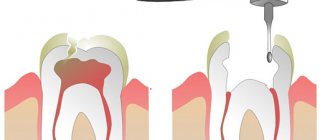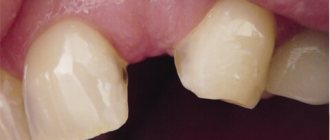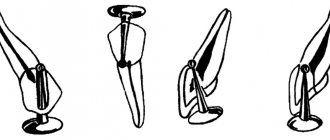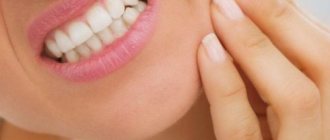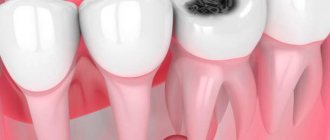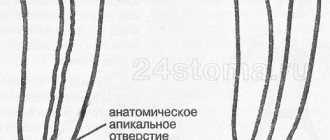Content
- Indications for stump restoration
- Formation of a tooth stump
- Dental prosthetics
- Care after crown installation
A tooth stump is a smaller version of a tooth onto which a crown is subsequently fixed. If there is enough natural tooth tissue, the stump can be easily formed using the preparation method. If there is not enough natural material, it is necessary to restore the stump under a prosthesis. There are several ways to do this.
PROMOTION
Installation of crowns, dental bridge
RUB 3,450
What are stump inlays used for?
Before placing a crown on a tooth, it is important to prepare a base that will support it. In the presence of a healthy root, the role of the base is played by the stump of the dental organ itself. If the root is destroyed or there is not enough protruding tissue to attach the crown, it is usually removed and an implant is implanted.
The specialist can determine what the crown will be attached to by removing all the affected tissue using a drill and determining whether the patient’s own dental tissue will be sufficient or whether an inlay will have to be placed.
If there is enough native tissue, the crown will be attached to its own stump. Before the procedure, the nerve in the tooth is removed, cleaned, ground down into a stump shape and, if necessary, strengthened with a pin. Then an impression of the stump is made, according to which the crown will be made.
For many patients, this method is preferable. Indeed, with this method of prosthetics, most of the tissue of a living organ is preserved. But experts in this field, on the contrary, consider the use of pins in prosthetics without installing inlays to be unreliable, since this method can lead to the destruction of the tissue of a living dental organ under the prosthesis, reducing its service life.
Another option is to completely remove the crown of the tooth and prepare it for a metal or ceramic inlay. This service is more expensive, because you need to pay for both the work during installation and the work during the manufacture of structures in the laboratory. But after such manipulation the crown is much more securely fixed.
The price for installing an inlay varies depending on the number of roots of the dental organ. The design for single-root and double-root dental organs costs approximately five to seven thousand rubles. And for multi-rooted teeth, the cost increases.
When is stump restoration required?
It is necessary to give the remaining tissues of the upper part of the tooth the desired shape in order to subsequently successfully secure the prosthesis - a crown or bridge. A properly shaped stump is required:
- After endodontic treatment, when tooth restoration with a filling or inlay is undesirable.
- In case of severe destruction of the crown, when restoration by other methods is impractical.
It is important to provide the crown with reliable support. In this case, the tooth root can be preserved for a long time.
What is a stump tab?
To restore a tooth affected by caries and carry out its restoration, several methods are used. The easiest way is to install a filling after careful treatment of the cavity.
Absolutely every dentist does fillings. This procedure is inexpensive. But the result does not always completely satisfy the patient. The filling may differ in color from the enamel surface, and after a while it may even darken. If filling is carried out on the front dental organs, this becomes almost a disaster, since the aesthetics of the smile suffers greatly. However, in the case of a large chip on the front incisor, it will not be possible to repair it with filling material. The filling will not hold well and will look unattractive.
For these reasons, restorative ceramic inlays are often used to restore a tooth. This procedure is more expensive than filling, but has proven itself very well in dentistry.
It is advisable to use an inlay instead of a filling if part of the tooth has broken off, or caries has affected more than sixty percent of its tissues.
The inlay is an orthopedic structure, namely a non-removable microprosthesis. A tooth restoration procedure is carried out using a stump inlay in two or three visits to an orthodontist.
Orthopedic inlays are made from the following materials:
- photosensitive composite materials;
- metals (preferably noble);
- pressed ceramics;
- metal ceramics;
- non-metallic zirconium alloys.
The use of stump inlays not only aims to restore the tissues of a separate dental organ, they can also be used to secure bridges when there is a defect. In this case, ceramic inserts play the role of locks on adjacent teeth.
The price of such products varies greatly depending on the material used. The average cost of a stump tab is 15,000 rubles. At the same time, the work of a specialist installing this microprosthesis is paid additionally in most cases.
It happens that a destroyed dental organ can no longer be saved. When the coronal part is completely missing, it will not be possible to restore it with microprosthetics. It is better to use an artificial crown in such a situation. This way the healthy root will be preserved.
In order to securely attach the crown, a base of its tissues is left on the dental organ. In case of severe tissue damage, a stump insert is used, which will perform a technological rather than a cosmetic function.
Stump inlays are made individually for each patient.
How does the stump form?
Several methods are used depending on the situation:
- Formation of a stump without a pin. This is possible if the tooth is not severely damaged and there is enough healthy tissue to provide reliable support for the crown.
- Creation of a stump supported by a pin. In this case, the channel, which was previously tightly sealed, expands and a pin is inserted into it. The pin is fixed to durable cement and serves to hold the material and compensate for the chewing load in the future.
- Installation of the stump tab. This approach is used when there is little native tissue and creating a stump from a composite material is impractical.
How is the treatment performed?
Treatment is carried out in stages.
- Diagnosis of tooth condition. The length of the root must exceed the height of the crown, the walls must have a thickness of at least 1 mm. Inflammation, cysts and other pathologies are excluded. This is very important, since the stump can only be removed with the tooth.
- Preparation of tissue under the inlay to a height of 1-2 mm above the gum edge.
- Taking an impression and sending it to the laboratory.
- Installation. First, additional pins are cut off, which are located on top of the insert. They are broken off after installation, the surface is polished. Then the channels are filled with a cementitious composition, the material is applied to the pins, and the inlay is fixed.
- Preparing the tooth for fixation of the crown and then installing the crown in stages.
Prosthetics
When the inlay is ready, a crown can be installed on it. If we are talking about the front part of the dentition and a crown made of ceramics or zirconium dioxide, the inlay should be light. Crowns made from these materials are as close in appearance to natural teeth as possible. They also have the required level of transparency. The metal stump insert will be visible through the ceramic layer. Therefore, it is important that the support meets aesthetic requirements. A composite stump based on a pin or an intraradicular stump made of zirconium dioxide can be used.
For prosthetics of chewing teeth, strength is much more important than aesthetics. In this area, metal ceramics are often used, for which the color of the stump is not important and the main role is played by its ability to withstand loads. When the stump is ready, an impression is taken of the jaw to make a model. Based on this model, a crown is subsequently made.
From the point of view of reliability, the option with prosthetics based on a stump intraradicular inlay is considered preferable. Reinforcement with pins is considered less reliable and is associated with the risk of destruction of the restoration.
Inversion prosthetics method: restoration of the tooth stump and fixation of a metal-free crown
Highly aesthetic works from metal ceramics, press ceramics and frame ceramics on zirconium and aluminum oxide are a reality today. The skills and craftsmanship of the medical technician team create masterpieces that stun patients with their results. Today, aesthetic rehabilitation services can improve the patient’s personal status and sometimes change their fate.
But there is also a downside to this happiness: a chip of a fragment of ceramics, a chip of a veneer, a disintegration of an orthopedic crown, and sometimes even a defect in the tooth stump. Moments of happiness stop at this moment for our patient. The beloved restoration is no longer pleasing to the eye. The request to reuse a crown that has become cemented is most often the only request from the patient. It is not difficult to re-cement the crown with the remaining tooth stump. But the situation is completely different when decementation is accompanied by a defect in the tooth stump.
In this clinical case, I will show how to effectively and accurately carry out the inversion (reverse) prosthetics method.
Clinical case
Patient M., 35 years old, came to the clinic with complaints of decementing of an aluminum oxide crown by 2.1. Objectively: the crown had a movable position on the stump of tooth 2.1 and was removed without effort. A chipping of 1/3 of the tooth stump was noted (the inner part of the crown was filled with the separated fragment).
Defect of stump of 2.1 tooth
In the past, the tooth was subjected to endotherapy followed by restoration using a polymer pin. There was complete preservation of the polymer pin throughout. Only the inner surface of the crown with a fragment of core material broke off.
Recovery stages
Stage 1. Preparing the tooth core.
The surface of the tooth stump was slightly prepared in order to remove unreliable fragments of the composite stump material. After this, according to the adhesive protocol, the acid was applied for 15 seconds, rinsed off generously, the surface was left slightly moistened, and the adhesive system was applied. I used All Bond 3 adhesive (Bisco IL, USA). This is a universal dual-curing adhesive; it has a modified structure of the polymer matrix and is maximally stable on the dentin substance after polymerization due to its hydrophobicity. After preparation and polymerization, the dentin surface has a shiny appearance. This is good.
Prepared tooth stump for restoration
Stump restored with a crown
Stage 2. Crown preparation.
The inner surface of the crown is covered with insulating material. I used PRO-V COAT (Bisco IL, USA). This material creates a completely inert surface that prevents the fixation of any composite. In addition, it is highly washable and was originally intended to isolate the surface of the tooth structure from the temporary composite material in InLay & Overlay cases. But you can also use glycerin or water-soluble gel lubricant.
The crown is carefully removed from the restored tooth stump. This process may be accompanied by slight effort. The crown is very clearly fitted to the restored tooth stump. The use of release agents (in my case, PRO-V COAT) makes this procedure always predictable.
Stage 3. Fixation of the crown on the restored tooth stump.
Materials used for the adhesive fixation technique: All Bond 3 adhesive, primer for zirconium oxide, aluminum and metal Z-PRIMER PLUS, light-curing composite cement Choice 2
I use an adhesive bonded aluminum oxide crown. To do this, the inner surface of the aluminum oxide crown is sandblasted using aluminum oxide powder 50 microns at a pressure of up to 2 atm. at an oblique angle to the surface.
Degrease in alcohol or acetone and dry. A primer for zirconium oxide and aluminum Z-PRIMER PLUS (Bisco IL, USA) is applied to the inner surface of the crown for 30 seconds. Drying. The surface of the crown is ready.
The inner surface of the framework ceramics is treated with the primer Z-PRIMER PLUS (Bisco IL, USA)
The newly created tooth stump is subjected to an adhesive protocol: etched, All Bond 3 adhesive is applied, and polymerized. We add light-curing composite cement to the crown. The crown is adapted to the tooth stump. Excess cement undergoes 2-second polymerization, is removed from the edges of the crown, and transcoronal polymerization is performed on each side for 30 seconds.
Comments and clarifications:
- When working with metal-ceramics, I use chemical or dual-curing composites (Luxa-Core (DMG), Core-Flo, Bisfill 2B (Bisco)) as core materials.
- The surface of the tooth core when using chemical or dual-curing materials must be coated with adhesive systems compatible with such materials.
conclusions
Long-term clinical observations show the reliability and accuracy of the inversion prosthetics method. This technique can be successfully used in current clinical situations.
Pros of stump inlays
A pin inserted into a living tooth stump holds the crown well, but how long the structure will last greatly depends on the condition of the living tissues under the prosthesis. The pin serves the purpose of strengthening the ground part of the tooth; without it, it can break off. If these tissues are affected by caries or periodontitis, the living stump may become unsafe and the tooth will need to be removed.
When an artificial stump is used, the living dental organ is completely ground down, leaving only its root. The pulp is removed and the canals are filled. These tasks are carried out by a dental therapist, who then refers the patient to an orthodontist. He partially unfills the canals, attaches pins to a hole or several holes (for a multi-rooted tooth), and makes an impression of the base of the dental organ.
The impression serves as the basis for the manufacture of an orthopedic stump inlay. It must be strong in order to become a good support for the prosthesis and correspond to the physiological indicators of its future wearer. Thanks to modern materials used to make inlays, they are resistant to corrosion and destruction.
Note: The only nuance that can provoke the loss of a dental organ even with an artificial inlay installed is the inflammatory process of the base of the root in the alveolus.
This can cause suppuration in the hole and the formation of gumboil. Pain in the tooth where the inlay was installed requires an x-ray to be taken to identify possible areas of inflammation.
Pros and cons of pins
The main advantages of pins are:
- Their installation requires a small amount of dental tissue preparation.
- You can restore a tooth in just one visit to the dentist.
- Installing a pin is relatively inexpensive.
- Reliable fixation in the dental canal.
If you have a problem similar to that described in this article, be sure to contact our specialists. Don't diagnose yourself!
Why you should call us now:
- We will answer all your questions in 3 minutes
- Free consultation
- The average work experience of doctors is 12 years
- Convenient location of clinics
Single contact phone number: +7
Make an appointment
Flaws:
- The fragility of the structure - on average, a tooth with a pin restoration is destroyed in 3-4 years.
- There is insufficient adhesion between the pin rod and the crown - under heavy load, the structure may separate.
- If the size of the structure is chosen incorrectly, dental tissue can be destroyed quite quickly.
Tab Features
A dental inlay is a special device that is used in case of complete destruction of a dental unit individually for each patient. At their core, such structures resemble a filling, which is created in a clinical laboratory using a previously taken impression of the jaw. This technology is one of the types of fixed prosthetics.
A dental inlay is a device that allows you to evenly distribute the load on the jaw apparatus.
Pin – a rod-shaped structure installed in the root part. Only a specialist can help you make the right choice in favor of any product, based on the task that needs to be completed.
In terms of visual and aesthetic characteristics, a dental inlay has significant differences compared to a filling. In shape, such a prosthesis is similar to a molar and has all identical shapes and colors.
In most cases, inlays are installed on the posterior units of the dentition. Such devices can also be used as a supporting structure for installing a bridge.
Classification
By type, the tabs are divided into:
- restorative - designed, if necessary, to completely restore the shape and color of the dental crown;
- stump - used to restore the lost part of a tooth, on which a crown is subsequently placed.
Gutta-percha points
In medicine, special pastes were previously used to fill root canals.
Depending on the material used, the designs are:
- metal-ceramic;
- metal;
- composite;
- ceramic.
Inserts can also be of the following variety:
- devices of non-demountable type;
- dismountable products;
- structures made using zirconium dioxide.
What exactly to apply is decided by the specialist individually.
Indications and contraindications
Tabs are installed in the following cases:
- there is intense destruction of the upper part of the dental unit, while the dental canal has no pathologies;
- there was a need to strengthen the dentin before installing a bridge or crown.
It is not recommended to fix the product on the tooth in the presence of such pathological conditions as:
- cyst;
- inflammatory process, as a result of which the tooth tissues are damaged;
- granulomas;
- allergy to the material from which the device is made;
- strong mobility of dental units;
- poorly treated canal.
Before performing the implantation procedure, orthodontists refer the patient to donate blood for analysis and x-rays of both jaws.
Dental care after the installation of a core tab
Stump inlays do not require complex specific care. All you need to do is maintain oral hygiene, brush your teeth regularly and undergo periodic dental examinations and professional hygiene procedures.
To clean crowns installed on teeth with core inlays, it is best to use brushes with soft bristles; it will also be useful to rinse your mouth after each meal - with a special balm or just clean water. When brushing your teeth, it is important to clean them from all sides and be sure to thoroughly clean the interdental spaces. For this purpose, special brushes and dental floss are used.
Filling on a pin or crown: which is better?
This question interests many patients, and the answer is obvious. From the point of view of strength and reliability, the best option would be to install a pin and a crown. It is better to place a pin in a tooth under a crown in cases where the tooth is significantly damaged, especially when it comes to molars. A pin with a filling is installed for less significant damage and most often on the front teeth. This method also has its advantages. Firstly, this is a much cheaper technique. Secondly, all treatment takes place in one visit. The patient quickly returns to normal life and forgets about his problem. However, a filling with a pin gives a less reliable and predictable result.
Pin Features
The pin is a structure shaped like a rod. It is designed to strengthen a damaged tooth. It is usually fixed in the root canal of the tooth.
It is also possible to install a pin in cases where there is severe tooth loss, and the only solution for restoration is to build it onto a pin.
Modern dental clinics can offer many different types of post structures.
Varieties
Depending on the material used, products are classified into:
- Standard. They can be presented in the form of a cylindrical or conical shape. These types of pins are used when there is slight destruction of the dental unit. A special tool is used to adjust the rod to the root tissue.
- Metal. Their use is advisable in cases of severe damage. The pin, made of titanium, helps to effectively strengthen the part that has undergone restoration.
- Fiberglass. This material is characterized by increased elasticity and is not able to react with the prosthesis and human saliva. In addition, fiberglass is invisible through a crown or filling. Rods made from this material are very popular and have recently replaced the metal pin.
- Individual. The product is manufactured taking into account the relief of a particular root. Such pins are characterized by increased reliability compared to standard ones, since they are able to hold a tooth even in a weak root canal.
- Carbon fiber. This is a more modern version of the pin design. They are stronger and are able to evenly distribute the chewing load inside the root.
- Anchor. A titanium alloy is used to make such a rod. Today this is one of the popular and more effective methods of restoring lost units.
Pin-stump inlay
Among the main objectives of dentistry is the preservation and restoration of teeth, regardless of the degree of their destruction.
According to the shape of the root system channel, the pins are divided into:
- screw;
- conical;
- cylindrical;
- cylindrical.
The pin can be fixed in two ways:
- active;
- passive.
In the first case, the rod is attached to the dentin. This type of fastening is considered the most reliable. The pin has a thread with which it is screwed into the bone tissue.
This method is used when restoration of an almost completely destroyed dental unit is required. However, it is worth mentioning that the active pin can create increased tension, resulting in an increased risk of tooth fracture.
The longer a decayed tooth remains unloaded, the greater the likelihood that atrophy of the bone tissue underneath will occur.
In this case, restoration of the jaw tissue may be required before performing dental procedures. More often, artificial gum or bone augmentation is performed.
Dentist
Novikova Olga Alexandrovna
8 years of experience
When using a passive type of product, fixation is carried out using a special dental composition. The method is advisable for the purpose of strengthening the unit after treatment.
When can a pin be placed?
The pin design is indicated in the following situations:
- the crown part of the tooth has more than 50 percent of the destroyed surface;
- the dental crown is completely missing;
- you need to create a support for a removable or non-removable product.
Fiberglass pins
To restore a tooth, most of which has been destroyed, a fiberglass pin is used in dentistry.
It is not recommended to install pins if there are:
- diseases ;
- damage ;
- inflammatory processes;
- carious lesions;
- cyst or granuloma of the oral cavity;
- pathologies of the central nervous system.
In addition, inappropriate root length relative to the height of the coronal part and if the thickness of the root wall is less than two millimeters are considered contraindications.
What you need to know
The type of construction is selected based on the client’s financial capabilities and wishes, as well as the degree of destruction. In any case, when choosing one type of pin or another, you must listen to the opinion of a specialist.
Why can our articles be trusted?
We make health information clear, accessible and relevant.
- All articles are checked by practicing doctors.
- We take scientific literature and the latest research as a basis.
- We publish detailed articles that answer all questions.
When choosing a suitable design, it is important to take into account the following points:
- How badly is destroyed , as well as how thick its walls are.
- At what level relative to the gingival tissue did the damage occur?
- load distribution on the tooth. Is it a support for a prosthesis or stands alone?
The choice of material used should also be treated with special attention. It is important to take into account the general health of the patient and the ability to take the necessary actions after treatment.
What to choose?
Judging by the above data, both types of structures have their positive and negative qualities. So, what is better, a pin or an inlay, and what should you choose? There is no clear answer to this question, since the choice will depend on the clinical situation, the degree of tooth decay and possible indications. It is best to immediately contact an orthopedic dentist for consultation, who will accurately determine whether it is possible to install a pin structure with subsequent restoration of the coronal part or whether a stump inlay will be required immediately.
Service life and design reliability
The service life of a crown on a tooth on a pin is quite decent if the treatment was carried out efficiently, and the patient avoided injury and followed the doctor’s recommendations. Even a classic metal-ceramic crown with a simple anchor pin costs on average 7–8 years. A more expensive ceramic crown on a fiberglass post will last even longer.
If during use the crown begins to wobble, then this is a bad sign, regardless of whether it is with a pin or without a pin. In this case, you need to consult a doctor as soon as possible. If the crown and pin fall out completely, this may be due to improper treatment, pathological processes in the root canals, or a banal injury. Repeated treatment in most cases is no longer possible.
Restoration methods
In the case of restoring a tooth stump, the dentist can use two main methods of restoration:
- In case of minor damage to the tooth structure, with little damage to the anatomical shape, inlays are used for restoration, which help restore the tooth’s strength and shape, as well as functionality. In addition, dentists often use veneers for restoration.
- The direct restoration method is used to restore a badly damaged tooth or its complete absence. The technique involves modeling and restoration of the tooth by introducing an anchor pin into the gum, which creates the necessary support for further restoration. The material used is a composite, which has strength and the necessary shade. Most often used to restore chewing teeth.
If a tooth is completely destroyed, the dentist, in addition to the composite, can use glass ionomer, which helps enhance the effect of the composite. In addition, the material has many advantages, such as lack of toxicity, good aesthetic effect, and durability.
